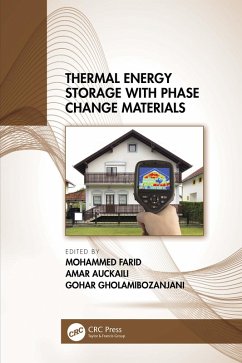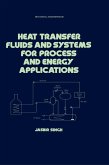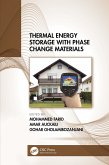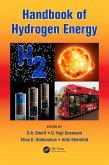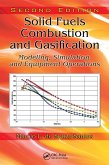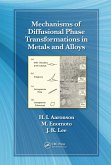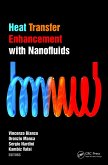Thermal Energy Storage with Phase Change Materials (eBook, ePUB)
Redaktion: Farid, Mohammed; Gholamibozanjani, Gohar; Auckaili, Amar
52,95 €
52,95 €
inkl. MwSt.
Sofort per Download lieferbar

26 °P sammeln
52,95 €
Als Download kaufen

52,95 €
inkl. MwSt.
Sofort per Download lieferbar

26 °P sammeln
Jetzt verschenken
Alle Infos zum eBook verschenken
52,95 €
inkl. MwSt.
Sofort per Download lieferbar
Alle Infos zum eBook verschenken

26 °P sammeln
Thermal Energy Storage with Phase Change Materials (eBook, ePUB)
Redaktion: Farid, Mohammed; Gholamibozanjani, Gohar; Auckaili, Amar
- Format: ePub
- Merkliste
- Auf die Merkliste
- Bewerten Bewerten
- Teilen
- Produkt teilen
- Produkterinnerung
- Produkterinnerung

Bitte loggen Sie sich zunächst in Ihr Kundenkonto ein oder registrieren Sie sich bei
bücher.de, um das eBook-Abo tolino select nutzen zu können.
Hier können Sie sich einloggen
Hier können Sie sich einloggen
Sie sind bereits eingeloggt. Klicken Sie auf 2. tolino select Abo, um fortzufahren.

Bitte loggen Sie sich zunächst in Ihr Kundenkonto ein oder registrieren Sie sich bei bücher.de, um das eBook-Abo tolino select nutzen zu können.
This book focuses on latent heat storage, which is one of the most efficient ways of storing thermal energy. Unlike the sensible heat storage method, latent heat storage method provides much higher storage density, with a smaller difference between storing and releasing temperatures.
- Geräte: eReader
- mit Kopierschutz
- eBook Hilfe
Andere Kunden interessierten sich auch für
![Computational Modeling of Underground Coal Gasification (eBook, ePUB) Computational Modeling of Underground Coal Gasification (eBook, ePUB)]() Vivek V. RanadeComputational Modeling of Underground Coal Gasification (eBook, ePUB)186,95 €
Vivek V. RanadeComputational Modeling of Underground Coal Gasification (eBook, ePUB)186,95 €![Heat Transfer Fluids and Systems for Process and Energy Applications (eBook, ePUB) Heat Transfer Fluids and Systems for Process and Energy Applications (eBook, ePUB)]() Jasbir SinghHeat Transfer Fluids and Systems for Process and Energy Applications (eBook, ePUB)146,95 €
Jasbir SinghHeat Transfer Fluids and Systems for Process and Energy Applications (eBook, ePUB)146,95 €![Thermal Energy Storage with Phase Change Materials (eBook, PDF) Thermal Energy Storage with Phase Change Materials (eBook, PDF)]() Thermal Energy Storage with Phase Change Materials (eBook, PDF)52,95 €
Thermal Energy Storage with Phase Change Materials (eBook, PDF)52,95 €![Handbook of Hydrogen Energy (eBook, ePUB) Handbook of Hydrogen Energy (eBook, ePUB)]() Handbook of Hydrogen Energy (eBook, ePUB)229,95 €
Handbook of Hydrogen Energy (eBook, ePUB)229,95 €![Solid Fuels Combustion and Gasification (eBook, ePUB) Solid Fuels Combustion and Gasification (eBook, ePUB)]() Marcio L. de Souza-SantosSolid Fuels Combustion and Gasification (eBook, ePUB)192,95 €
Marcio L. de Souza-SantosSolid Fuels Combustion and Gasification (eBook, ePUB)192,95 €![Mechanisms of Diffusional Phase Transformations in Metals and Alloys (eBook, ePUB) Mechanisms of Diffusional Phase Transformations in Metals and Alloys (eBook, ePUB)]() Hubert I. AaronsonMechanisms of Diffusional Phase Transformations in Metals and Alloys (eBook, ePUB)135,95 €
Hubert I. AaronsonMechanisms of Diffusional Phase Transformations in Metals and Alloys (eBook, ePUB)135,95 €![Heat Transfer Enhancement with Nanofluids (eBook, ePUB) Heat Transfer Enhancement with Nanofluids (eBook, ePUB)]() Heat Transfer Enhancement with Nanofluids (eBook, ePUB)74,95 €
Heat Transfer Enhancement with Nanofluids (eBook, ePUB)74,95 €-
-
-
This book focuses on latent heat storage, which is one of the most efficient ways of storing thermal energy. Unlike the sensible heat storage method, latent heat storage method provides much higher storage density, with a smaller difference between storing and releasing temperatures.
Dieser Download kann aus rechtlichen Gründen nur mit Rechnungsadresse in A, B, BG, CY, CZ, D, DK, EW, E, FIN, F, GR, HR, H, IRL, I, LT, L, LR, M, NL, PL, P, R, S, SLO, SK ausgeliefert werden.
Produktdetails
- Produktdetails
- Verlag: Taylor & Francis eBooks
- Seitenzahl: 464
- Erscheinungstermin: 25. Juli 2021
- Englisch
- ISBN-13: 9781000406641
- Artikelnr.: 62060212
- Verlag: Taylor & Francis eBooks
- Seitenzahl: 464
- Erscheinungstermin: 25. Juli 2021
- Englisch
- ISBN-13: 9781000406641
- Artikelnr.: 62060212
- Herstellerkennzeichnung Die Herstellerinformationen sind derzeit nicht verfügbar.
Professor Mohammed Mehdi Farid is a full professor (Personal Chair) at the University of Auckland, New Zealand. Dr Amar Auckaili is a professional teaching fellow at the University of Auckland, New Zealand. Dr. Gohar Gholambozanjani is a research assistant at the University of Auckland, New Zealand.
1. Phase Change Material Selection and Performance 1.1 A Review on Phase
Change Energy Storage: Materials and Applications 1.2 Fire Retardants for
Phase Change Materials 1.3 Long-Term Thermal Stability of Organic PCMs 1.4
A Novel Calcium Chloride Hexahydrate-Based Deep Eutectic Solvent as a Phase
Change Material 2. Mathematical Analysis of Phase Change Processes 2.1 A
New Approach in the Calculation of Heat Transfer with Phase Change 2.2
Effect of Natural Convection on the Process of Melting and Solidification
of Paraffin Wax 2.3 The Role of Natural Convection during Melting and
Solidification of PCM in a Vertical Cylinder 2.4 Thermal Performance of a
Heat Storage Module Using PCMs with Different Melting Temperatures:
Mathematical Modeling 2.5 Performance of Direct Contact Latent Heat Storage
Units with Two Hydrated Salts 3. Energy Saving, Peak Load Shifting and
Price-Based Control Heating: Passive Applications 3.1 A Review on Energy
Conservation in Building Applications with Thermal Storage by Latent Heat
Using Phase Change Materials 3.2 Impact of Energy Storage in Buildings on
Electricity Demand Side Management 3.3 Experimental Validation of a
Methodology to Assess PCM Effectiveness in Cooling Building Envelopes
Passively 3.4 Peak Load Shifting with Energy Storage and Price-Based
Control System 3.5 Application of Weather Forecast in Conjunction with
Price-Based Method for PCM Solar Passive Buildings - An Experimental Study
3.6 Application of PCM Energy Storage in Combination with Night Ventilation
for Space Cooling 3.7 Application of PCM Under¿oor Heating in Combination
with PCM Wallboards for Space Heating Using Price-Based Control System 3.8
Analysis of Energy Requirements versus Comfort Levels for the Integration
of Phase Change Materials in Buildings 3.9 Benefits of PCM Underfloor
Heating with PCM Wallboards for Space Heating in Winter 4. Energy-Saving,
Peak Load Shifting and Price-Based Control Heating and Cooling: Active
Applications 4.1 Application of an Active PCM Storage System into a
Building for Heating/Cooling Load Reduction 4.2 Peak Load Shifting Using a
Price-Based Control in PCM-Enhanced Buildings 4.3 Model Predictive Control
Strategy Applied to Different Types of Building for Space Heating 4.4 A
Comparison between Passive and Active PCM Systems Applied to Buildings
Change Energy Storage: Materials and Applications 1.2 Fire Retardants for
Phase Change Materials 1.3 Long-Term Thermal Stability of Organic PCMs 1.4
A Novel Calcium Chloride Hexahydrate-Based Deep Eutectic Solvent as a Phase
Change Material 2. Mathematical Analysis of Phase Change Processes 2.1 A
New Approach in the Calculation of Heat Transfer with Phase Change 2.2
Effect of Natural Convection on the Process of Melting and Solidification
of Paraffin Wax 2.3 The Role of Natural Convection during Melting and
Solidification of PCM in a Vertical Cylinder 2.4 Thermal Performance of a
Heat Storage Module Using PCMs with Different Melting Temperatures:
Mathematical Modeling 2.5 Performance of Direct Contact Latent Heat Storage
Units with Two Hydrated Salts 3. Energy Saving, Peak Load Shifting and
Price-Based Control Heating: Passive Applications 3.1 A Review on Energy
Conservation in Building Applications with Thermal Storage by Latent Heat
Using Phase Change Materials 3.2 Impact of Energy Storage in Buildings on
Electricity Demand Side Management 3.3 Experimental Validation of a
Methodology to Assess PCM Effectiveness in Cooling Building Envelopes
Passively 3.4 Peak Load Shifting with Energy Storage and Price-Based
Control System 3.5 Application of Weather Forecast in Conjunction with
Price-Based Method for PCM Solar Passive Buildings - An Experimental Study
3.6 Application of PCM Energy Storage in Combination with Night Ventilation
for Space Cooling 3.7 Application of PCM Under¿oor Heating in Combination
with PCM Wallboards for Space Heating Using Price-Based Control System 3.8
Analysis of Energy Requirements versus Comfort Levels for the Integration
of Phase Change Materials in Buildings 3.9 Benefits of PCM Underfloor
Heating with PCM Wallboards for Space Heating in Winter 4. Energy-Saving,
Peak Load Shifting and Price-Based Control Heating and Cooling: Active
Applications 4.1 Application of an Active PCM Storage System into a
Building for Heating/Cooling Load Reduction 4.2 Peak Load Shifting Using a
Price-Based Control in PCM-Enhanced Buildings 4.3 Model Predictive Control
Strategy Applied to Different Types of Building for Space Heating 4.4 A
Comparison between Passive and Active PCM Systems Applied to Buildings
1. Phase Change Material Selection and Performance 1.1 A Review on Phase
Change Energy Storage: Materials and Applications 1.2 Fire Retardants for
Phase Change Materials 1.3 Long-Term Thermal Stability of Organic PCMs 1.4
A Novel Calcium Chloride Hexahydrate-Based Deep Eutectic Solvent as a Phase
Change Material 2. Mathematical Analysis of Phase Change Processes 2.1 A
New Approach in the Calculation of Heat Transfer with Phase Change 2.2
Effect of Natural Convection on the Process of Melting and Solidification
of Paraffin Wax 2.3 The Role of Natural Convection during Melting and
Solidification of PCM in a Vertical Cylinder 2.4 Thermal Performance of a
Heat Storage Module Using PCMs with Different Melting Temperatures:
Mathematical Modeling 2.5 Performance of Direct Contact Latent Heat Storage
Units with Two Hydrated Salts 3. Energy Saving, Peak Load Shifting and
Price-Based Control Heating: Passive Applications 3.1 A Review on Energy
Conservation in Building Applications with Thermal Storage by Latent Heat
Using Phase Change Materials 3.2 Impact of Energy Storage in Buildings on
Electricity Demand Side Management 3.3 Experimental Validation of a
Methodology to Assess PCM Effectiveness in Cooling Building Envelopes
Passively 3.4 Peak Load Shifting with Energy Storage and Price-Based
Control System 3.5 Application of Weather Forecast in Conjunction with
Price-Based Method for PCM Solar Passive Buildings - An Experimental Study
3.6 Application of PCM Energy Storage in Combination with Night Ventilation
for Space Cooling 3.7 Application of PCM Under¿oor Heating in Combination
with PCM Wallboards for Space Heating Using Price-Based Control System 3.8
Analysis of Energy Requirements versus Comfort Levels for the Integration
of Phase Change Materials in Buildings 3.9 Benefits of PCM Underfloor
Heating with PCM Wallboards for Space Heating in Winter 4. Energy-Saving,
Peak Load Shifting and Price-Based Control Heating and Cooling: Active
Applications 4.1 Application of an Active PCM Storage System into a
Building for Heating/Cooling Load Reduction 4.2 Peak Load Shifting Using a
Price-Based Control in PCM-Enhanced Buildings 4.3 Model Predictive Control
Strategy Applied to Different Types of Building for Space Heating 4.4 A
Comparison between Passive and Active PCM Systems Applied to Buildings
Change Energy Storage: Materials and Applications 1.2 Fire Retardants for
Phase Change Materials 1.3 Long-Term Thermal Stability of Organic PCMs 1.4
A Novel Calcium Chloride Hexahydrate-Based Deep Eutectic Solvent as a Phase
Change Material 2. Mathematical Analysis of Phase Change Processes 2.1 A
New Approach in the Calculation of Heat Transfer with Phase Change 2.2
Effect of Natural Convection on the Process of Melting and Solidification
of Paraffin Wax 2.3 The Role of Natural Convection during Melting and
Solidification of PCM in a Vertical Cylinder 2.4 Thermal Performance of a
Heat Storage Module Using PCMs with Different Melting Temperatures:
Mathematical Modeling 2.5 Performance of Direct Contact Latent Heat Storage
Units with Two Hydrated Salts 3. Energy Saving, Peak Load Shifting and
Price-Based Control Heating: Passive Applications 3.1 A Review on Energy
Conservation in Building Applications with Thermal Storage by Latent Heat
Using Phase Change Materials 3.2 Impact of Energy Storage in Buildings on
Electricity Demand Side Management 3.3 Experimental Validation of a
Methodology to Assess PCM Effectiveness in Cooling Building Envelopes
Passively 3.4 Peak Load Shifting with Energy Storage and Price-Based
Control System 3.5 Application of Weather Forecast in Conjunction with
Price-Based Method for PCM Solar Passive Buildings - An Experimental Study
3.6 Application of PCM Energy Storage in Combination with Night Ventilation
for Space Cooling 3.7 Application of PCM Under¿oor Heating in Combination
with PCM Wallboards for Space Heating Using Price-Based Control System 3.8
Analysis of Energy Requirements versus Comfort Levels for the Integration
of Phase Change Materials in Buildings 3.9 Benefits of PCM Underfloor
Heating with PCM Wallboards for Space Heating in Winter 4. Energy-Saving,
Peak Load Shifting and Price-Based Control Heating and Cooling: Active
Applications 4.1 Application of an Active PCM Storage System into a
Building for Heating/Cooling Load Reduction 4.2 Peak Load Shifting Using a
Price-Based Control in PCM-Enhanced Buildings 4.3 Model Predictive Control
Strategy Applied to Different Types of Building for Space Heating 4.4 A
Comparison between Passive and Active PCM Systems Applied to Buildings
